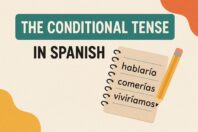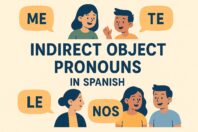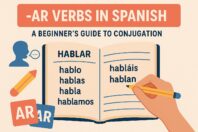Qué vs Cuál: How to Choose the Right Form of What and Which in Spanish

Get our free email course, Shortcut to Conversational.
Have conversations faster, understand people when they speak fast, and other tested tips to learn faster.
More infoChoosing between qué vs cuál isn’t always so obvious. You’ve probably learned that qué translates to what and cuál translates to which, right? Then why do you keep hearing “¿Cuál es tu nombre?” when you’re introducing yourself? Don’t worry, there is an answer to this dilemma.
The comparison between qué vs cuál, and what vs which, is not always exact because in Spanish there are some nuances that can change the intention of the question. In addition, in some cases we can use either qué or cuál without altering the meaning. Finally, there are a handful of fixed phrases based on qué which follow their own rules.
In this video, Mafalda gives a great lesson on the most important rules for using qué vs cuál in Spanish. In the rest of today’s post, we’ll look into even more detail at all of the possibilities we mentioned above. By the end of the lesson you’ll definitely know how to choose confidently and correctly between cuál vs qué.
Let’s get to it!
Qué vs Cuál: The Basics
Before we dive into their differences, let’s talk a little about the things they have in common.
Qué and cuál are question words. Qué is invariable, so it always has the same form regardless of whether the verb or noun that follows it is singular or plural. Cuál has two forms, so can be either cuál or cuáles when asking about singular or plural things.
Qué and cuál are considered interrogative adjectives when they accompany a noun, and as interrogative pronouns when they replace a noun and take a conjugated verb.
Let’s look at some examples of qué and cuál as interrogative adjectives:
- What book are you reading? – ¿Qué libro estás leyendo?
- Which color is prettier? – ¿Qué color es más bonito?
- Which animals have tails? – ¿Qué animales tienen cola?
- What options do you offer? – ¿Qué opciones ofrecen?
- Which flavor is better? – ¿Cuál sabor es mejor?
- Which house is bigger? – ¿Cuál casa es más grande?
- Which designs are available? – ¿Cuáles diseños están disponibles?
- Which cookies have peanuts? – ¿Cuáles galletas tienen maní?
Note that some Spanish learning resources say that using cuál and its plural form cuáles before a noun is incorrect. However, although it’s true that this usage is not very common in Spain, it is widely used in Latin America. This construction remains accepted by Spain’s Royal Spanish Academy.
Now let’s look at some examples of qué and cuál as interrogative pronouns:
- What is a star? – ¿Qué es una estrella?
- What are the planets? – ¿Qué son los planetas?
- What are you doing? – ¿Qué estás haciendo?
- What is your favorite color? – ¿Cuál es tu color favorito?
- Which is the tallest girl in the class? – ¿Cuál es la niña más alta de la clase?
- Which are mom’s shoes? – ¿Cuáles son los zapatos de mamá?
- What are the largest parks in the city? – ¿Cuáles son los parques más grandes de esta ciudad?
Qué vs Cuál: Learning the Differences
Now that we’ve covered the basics, we can focus on the heart of the matter. We’ve already seen that both qué and cuál can be translated as what or which, depending on the context. Now it’s time to get to know those contexts so you can choose the right one without needing to guess.
Qué vs Cuál + the verb ser
This can be one of the most confusing cases when learning Spanish, though it’s simpler than you might think.
It all comes down to the type of information you are looking for. In Spanish we use qué + ser to ask for definitions and explanations, while cuál + ser is used to ask for a specific name or identity.
With this in mind, cuál sometimes translates to which one when used with the verb ser. This occurs when there are a limited number of options to choose from.
Let’s look at some examples:
| English questions | Qué + ser: asking for a definition |
| What is friendship? | ¿Qué es la amistad? |
| What is a shooting star? | ¿Qué es una estrella fugaz? |
| What are viruses? | ¿Qué son los virus? |
| What are butterflies? | ¿Qué son las mariposas? |
| English questions | Cuál + ser: asking for a name or identity |
| What is your name? | ¿Cuál es tu nombre? |
| What is the capital of Bolivia? | ¿Cuál es la capital de Bolivia? |
| Which one is yours? | ¿Cuál es el tuyo? |
| Which one is my dog? | ¿Cuál es mi perro? |
| What are the hottest months of the year? | ¿Cuáles son los meses más calurosos del año? |
| What are the most beautiful countries in Europe? | ¿Cuáles son los países más bonitos de Europa? |
As you can see, the most important thing in this scenario is to understand the intention behind our question. That’s why when we want to know somebody’s name in Spanish, we have to use cuál and not qué, since what we really expect is a specific name and not a definition of what a name is.
Qué vs Cuál + verb: Choosing from a set of options
It is important to consider the set of options we’re choosing from when deciding between qué and cuál.
If the set of options is very broad, not limited to any fixed set of possibilities, we have to use qué. The options in this case can be very heterogeneous.
Alternatively, if the options are homogeneous with a known or limited set of possibilities, we use cuál. Note also that we use cuál + verb to choose between tangible things.
When we have to choose between intangible options we use qué, even if the options are limited or known.
Let’s look at some examples:
| English questions | Qué + verb: broad or intangible options |
| What are you going to buy, a house or a car? | ¿Qué vas a comprar, un carro o una casa? |
| What do you do on weekends? | ¿Qué haces los fines de semana? |
| What are we eating today? | ¿Qué comemos hoy? |
| What do you like better: the cold or the heat? | ¿Qué te gusta más: el frío o el calor? |
| Which do you prefer to study: English or mathematics? | ¿Qué prefieres estudiar: inglés o matemáticas? |
| English questions | Cuál + verb: homogeneous set of options |
| Look at those motorcycles, which one do we buy? | Mira esas motocicletas, ¿cuál compramos? |
| You practice many sports, which one is your favorite? | Practicas muchos deportes, ¿cuál es tu favorito? |
| There are chocolate and vanilla muffins, which ones do you prefer? | Hay magdalenas de chocolate y de vainilla, ¿cuáles prefieres? |
| They sell very nice shoes here, which ones do you like the most? | Aquí venden zapatos muy bonitos, ¿cuáles te gustan más? |
Qué de vs Cuál de: What about vs Which one
When using both qué and cuál, we can change the aspect of the question by using them with de. Fortunately for English speakers, when we use cuál vs qué along with de, the differences are much easier to spot. Let’s take a look at each one.
Qué de generally translates as what about. When we use qué de, we’re asking about a particular characteristic of something.
The combination of qué + de is also less common directly before the noun, so we’ll usually separate the two within the sentence. Let’s see this in the following examples, where we show both possible constructions in English and Spanish:
| English questions | Qué de: What about |
| What impressed you the most about the photograph?, What about the photograph impressed you the most? | ¿Qué les impresionó más de la fotografía?, ¿Qué de la fotografía les impresionó más? |
| What inspires you in these songs?, What about these songs inspire you? | ¿Qué te inspira de estas canciones?, ¿Qué de estas canciones te inspira? |
| What do you not like about these curtains?, What about these curtains don’t you like? | ¿Qué no te gusta de las cortinas?, ¿Qué de las cortinas no te gusta? |
In contrast, when we use cuál de, we’re always asking which one from within a specific set of options. The two words cuál + de always remain together in this formulation. Let’s see this construction in the following examples, with the various options for translating cuál de into English:
| English question | Cuál de: Which one of |
| Which one of these books is the longest? | ¿Cuál de estos libros es el más largo? |
| Which of these photographs were taken in Spain? | ¿Cuáles de estas fotografías fueron tomadas en España? |
| Which one of these cats is black? | ¿Cuál de estos gatos es negro? |
| Which of these cats have green eyes? | ¿Cuáles de estos gatos tienen ojos verdes? |
Qué vs cuál + nouns: Interrogative adjectives
As we saw at the beginning, qué and cuál can function as interrogative adjectives when they precede a noun. This is where English speakers’ confusion between cuál vs qué stems from, since we can usually use qué or cuál interchangeably when asking about nouns!
That being said, the rules we saw with verbs earlier become nuances here, in that cuál still conveys the nuance of choosing from within a finite set of options. This differentiation is really just applied in Latin America though, since in Spain they only use qué before a noun.
In other words, if you’re not sure about whether to use qué or cuál before a noun, just go with qué. Let’s demonstrate this with the following examples:
- What book did you read last night? – ¿Qué libro leíste anoche? – ¿Cuál libro leíste anoche?
- Which house is bigger? – ¿Qué casa es más grande? – ¿Cuál casa es más grande?
- Which shirt suits me best? – ¿Qué camisa me queda mejor? – ¿Cuál camisa me queda mejor?
- Which colors are warmer? – ¿Qué colores son más cálidos? – ¿Cuáles colores son más cálidos?
Qué phrases
Qué is found in a handful of common phrases where our explanations suggest we might prefer cuál, but which nonetheless always take qué. Take a look at this list so you’ll know to always use qué and not cuál in these cases:
| What time is it? | ¿Qué hora es? |
| What day is it? | ¿Qué día es? |
| What date is it? | ¿Qué fecha es? |
| How much…? | ¿Qué tanto…? |
| For what…?, What for…? | ¿Para qué…? |
| What color is…?, What color are…? | ¿De qué color es…?, ¿De qué color son…? |
Conclusion: Qué vs Cuál
We know that qué and cuál can be confusing when learning Spanish, so let’s do a quick recap before we finish.
We first saw that these question words can function as interrogative pronouns when they replace a noun and precede a conjugated verb, or as interrogative adjectives when they accompany a noun. We also saw that qué is invariable, while cuál has the plural form cuáles.
We then looked at the different contexts in which one or the other is used.
Qué is used to ask for definitions or explanations, or to choose from among a broad heterogeneous set of options. Qué is also a fixed part of a handful of common phrases like asking for the time or date in Spanish.
Cuál is used to ask for names, for specific information or to choose from among a homogeneous set of options. Cuál is also always used when asking to choose from among tangible things.
Finally, we saw that both qué and cuál are used with nouns in Latin America, while in Spain they only use qué . This is where qué and cuál can generally be used interchangeably.
We hope this post has given you a better understanding of qué vs cuál , and that you’re now more confident in using each one when speaking Spanish. To close, we’ll leave you with some exercises so you can practice what you’ve just learned!
Exercises
Read the following sentences and fill in the blanks by choosing between qué vs cuál. Remember that in some cases both options are correct.
1. ¿_____ es tu fruta favorita?
2. ¿_____ es más divertido, jugar al fútbol o al tenis?
3. ¿_____ son las guitarras de Daniel?
4. ¿_____ de estas arepas tiene jamón?
5. ¿_____ hora es?
6. ¿_____ es la ciencia?
7. ¿_____ son los tres países más grandes del mundo?
8. ¿_____ es tu dirección de correo electrónico?
9. ¿_____ niñas están usando vestidos?
10. ¿_____ de los tres libros fue escrito por Miguel de Cervantes?
11. ¿_____ blusa usas con más frecuencia?
Answers
1. ¿Cuál es tu fruta favorita? – What is your favorite fruit?
2. ¿Qué es más divertido: jugar al fútbol o al tenis? – Which is more fun: playing soccer or tennis?
3. ¿Cuáles son las guitarras de Daniel? – Which ones are Daniel’s guitars?
4. ¿Cuál de estas arepas tiene jamón? – Which one of these arepas has ham in it?
5. ¿Qué hora es? – What time is it?
6. ¿Qué es la ciencia? – What is science?
7. ¿Cuáles son los tres países más grandes del mundo? – What are the three biggest countries in the world?
8. ¿Cuál es tu dirección de correo electrónico? – What is your email address?
9. ¿Qué / Cuáles niñas están usando vestidos? – Which girls are wearing dresses?
10. ¿Cuál de los tres libros fue escrito por Miguel de Cervantes? – Which of the three books was written by Miguel de Cervantes?
11. ¿Qué / Cuál blusa usas con más frecuencia? – Which blouse do you wear most often?


